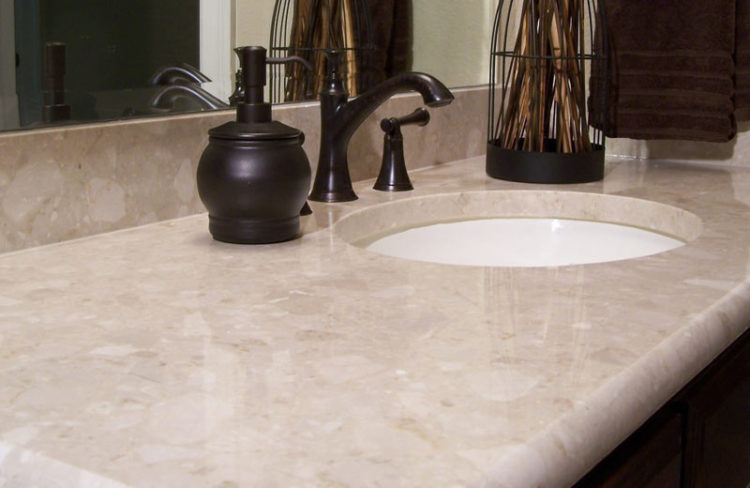Just like a car fresh off the lot, your new marble countertops are eventually going to get dinged. Stains happen. So does etching (when an acidic material eats away at the surface, leaving a dull spot). And chips and scratches, too.
When mishaps occur, there’s no need to hit the panic button. With the right know-how, you often can perform simple marble countertop repairs yourself.
First Things First: What Makes Marble Maintenance Different?
If you’ve opted to install marble countertops, you already know the pros and cons of this elegant and sophisticated material compared to, say, granite. While you can seal marble to protect it from damage, it must be redone periodically with a sealing product. Or you can forego sealing and allow it to develop an appealing au naturel patina.
While marble is largely resistant to damage from heat, it’s also softer and more porous than granite. It scores only a four on the industry’s Mohs hardness scale (which ranges from one to 10), compared to a rating of seven for granite and quartz. (Diamonds score a 10.) As such, marble countertops scratch more easily and are more prone to staining and etching when exposed to acidic substances — think coffee, red wine, or juice from lemons and other acidic fruits.
When an accident inevitably happens — like a spill, for instance — blot it immediately. (Wiping only spreads any potential stain farther afield.) Then wash the area with water and a mild detergent.
If you don’t notice spills and water marks right away, here are some marble countertop repair techniques you can try.
Your Stain-by-Stain Guide to Marble Countertop Repair
Oil-Based Stains
Grease, cooking oil, and other oil-based stains typically leave a darker stain than other substances. To remove these stains, you need to use a chemical that can dissolve oils. These include:
- Ammonia.
- Mineral spirits.
- Acetone.
- A liquid cleanser that includes bleach.
Organic Stains
For stains left by coffee, tea, and acidic fruits — or perhaps splatters from that amazing sugo you whipped up for a recent family gathering — you can repair your marble countertop by cleaning with a 12 percent (food-grade) hydrogen peroxide product mixed with just a few drops of ammonia.
Ink Stains
Bleach is good for cleaning ink stains (it works best on light-colored marble). As an alternative, try using hydrogen peroxide on light-colored marble and lacquer thinner on darker marble.
Nicks and Chips
So your knife slipped while cutting and took a little chip out of the countertop, thus creating an opportunity for another lesson in marble countertop repair. Here’s how to fix it:
- Thoroughly clean the area with acetone and a clean cloth.
- After applying a thin layer of epoxy — available at many home centers or countertop showrooms — carefully reset the chip in place.
- Wipe away any excess epoxy.
- Allow the adhesive to dry.
- Reseal it to restore the mirrorlike finish.
If you can’t find the chip, try using a filler product instead. (It’s also good for repairing small cracks.) And in the future, don’t forget to use a cutting board.
Water Spots and Rings
Prolonged exposure to hard water can be tough on marble countertops. To remove water spots and rings left by glasses and the like, buff them with extremely fine steel wool (look for #0000 on the package).
If that doesn’t work, polishing powders are a good alternative for relatively fast and no-mess marble countertop repair. To use polishing powders:
- Moisten the affected area.
- Sprinkle some polishing powder on the surface.
- Buff the surface with a soft cloth, using circular motions.
The friction between the towel and the slurrylike paste you’ve created should remove the scratches. After the shine is restored, use a marble cleaner to finish the job. Repeat if needed, and then reseal the area. (If your countertop was honed, which gives it an unreflective, mattelike finish, you may need to consult a professional.)
Another great way to remove deep-set stains is to prepare a poultice. Learn how to create and use one here.
Don’t let repairs keep you from making this iconic stone a part of your home — armed with the right knowledge, you can take on any marble mishap and keep your surface looking its best.
Ready to find the right marble surface for your home? Find a Santamargherita dealer near you to get started.
—
John Brodrick is the North American sales manager for Santamargherita. He has 17 years of experience in the manufacturing industry specializing in engineered surfaces for residential and commercial use. John has lent his expertise to projects worldwide ranging from airports and shopping malls to thousands of residential homes.

